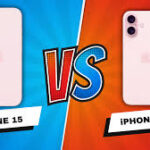The release of the iPhone 16 has sparked a lot of excitement in the tech world, but many Apple users are wondering whether it’s worth upgrading from the iPhone 15. While both models are packed with impressive features, the iPhone 16 comes with several key improvements that may make it a worthy investment for some users. In this article, we’ll break down the differences between the iPhone 16 and iPhone 15, focusing on hardware, performance, battery life, and features, to help you decide if it’s time to make the switch.
iPhone 16 vs iPhone 15: Design Changes
Design is one of the first aspects users notice when comparing new phone models. While both the iPhone 16 and iPhone 15 share Apple’s signature minimalist design, the iPhone 16 introduces some subtle but important refinements.
What’s new in the iPhone 16 design?
- Thinner Bezels: The iPhone 16 boasts even narrower bezels, offering a larger display area without increasing the overall size of the phone.
- Matte Glass Back: The back panel of the iPhone 16 now features a matte finish, providing a more premium feel and making the device more resistant to fingerprints.
- New Color Options: The iPhone 16 comes in fresh colors like Sunset Gold and Midnight Blue, giving users more variety compared to the standard color palette of the iPhone 15.
Comparison Conclusion: While the design improvements in the iPhone 16 are not revolutionary, they add a touch of refinement and sophistication that some users might appreciate. However, if you’re satisfied with the iPhone 15’s aesthetics, this change alone may not be a compelling reason to upgrade.
Display: ProMotion vs Standard Refresh Rate
One of the more noticeable differences between the two models is the display technology. The iPhone 16 comes equipped with a 120Hz ProMotion display, while the iPhone 15 still uses the standard 60Hz OLED display.
Why the ProMotion display matters:
- Smoother Scrolling: The higher refresh rate of the iPhone 16 offers significantly smoother scrolling, making everything from web browsing to gaming feel more fluid.
- Improved Responsiveness: ProMotion adjusts the refresh rate based on what you’re doing, conserving battery life while providing ultra-responsive performance when needed.
Comparison Conclusion: If you’re a power user who spends a lot of time gaming, using graphically intense apps, or simply enjoying a more fluid display experience, the upgrade to the iPhone 16’s ProMotion display is worth considering. However, if a standard 60Hz display satisfies your needs, this feature might not be a dealbreaker.
Performance: A18 Bionic Chip vs A17 Bionic Chip
Performance is always a crucial factor when considering an upgrade, and the iPhone 16 delivers a notable improvement thanks to its A18 Bionic chip. In comparison, the iPhone 15 is powered by the A17 chip.
iPhone 16 Performance Enhancements:
- Faster Processing: The A18 Bionic chip provides up to 20% faster CPU and GPU performance compared to the A17, making the iPhone 16 a beast for multitasking, gaming, and intensive applications.
- Improved Machine Learning: The A18 chip includes enhanced machine learning capabilities, which are crucial for photography, voice recognition, and real-time AI tasks.
- Energy Efficiency: Despite the increase in performance, the A18 chip is more energy-efficient, contributing to the iPhone 16’s improved battery life.
Comparison Conclusion: For users who regularly push their phones to the limit with gaming, video editing, or using resource-intensive apps, the A18 chip is a significant upgrade. However, if your daily use is limited to basic apps and social media, the A17 chip in the iPhone 15 is still more than capable.
Camera: Major Upgrades in the iPhone 16
The camera is one area where the iPhone 16 truly shines. Apple has significantly upgraded the camera system, making the iPhone 16 a more powerful tool for photography enthusiasts.
iPhone 16 Camera Upgrades:
- 48MP Main Sensor: The iPhone 16 features a 48-megapixel main sensor, a major leap from the iPhone 15’s 12MP sensor. This allows for higher-resolution photos and improved detail, especially in bright and complex lighting conditions.
- Improved Night Mode: The iPhone 16 has an upgraded Night Mode, delivering clearer, sharper images in low-light environments with less noise.
- 6x Optical Zoom: The iPhone 16 offers 6x optical zoom, double the zoom capabilities of the iPhone 15. This is a game-changer for anyone who loves to capture distant subjects without sacrificing image quality.
Comparison Conclusion: If mobile photography is a priority for you, the iPhone 16’s upgraded camera system offers substantial improvements. From higher resolution to enhanced zoom and night mode, the iPhone 16 outperforms the iPhone 15 in almost every camera-related aspect.
Battery Life: A Notable Improvement
Battery life is a crucial aspect for any smartphone user, and the iPhone 16 brings some solid improvements over the iPhone 15 in this area. Thanks to the A18 chip’s energy efficiency and a larger battery, the iPhone 16 offers up to 25% longer battery life than its predecessor.
